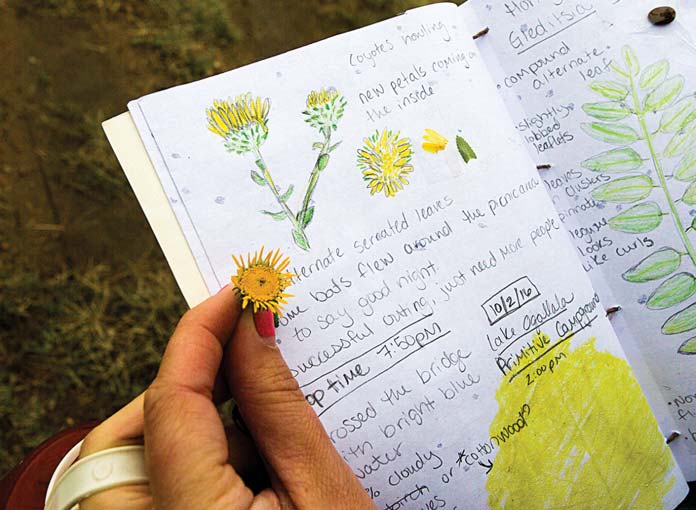
Here, she discovers a flower she journaled about at the same time the previous year.
For Holly Green, her peace of mind during finals in college could reliably be found in one place: between the pages of a black composition notebook.
The formula was pretty straight-forward: head to one of the bridges at Fort Kearny State Recreation Area, notebook in hand, and just observe: the morning fog over the water, chunks of ice floating down the river, brown bats silhouetted against the moon, the croaking of the bullfrog she dubbed “Romeo” for his incessant singing. Then she would write. “I’m not a person who writes down personal thoughts, but I like to capture a moment outside,” she commented. She still does – during the summer, nearly every day.
She’s not alone. People across the world, and throughout human history, have used nature journaling as a way to reconnect with nature, explore the outdoors more deeply and to make more lasting memories. The calm it often brings is a plus, too.
Nature journaling is a deeply personal endeavor, and looks slightly different for each person.
But a helpful working definition can be found in the book Keeping a Nature Journal by Clare Walker Leslie and Charles E. Roth:
“Simply put, nature journaling is the regular recording of observations, perceptions and feelings about the natural world around you. … Whereas a diary or personal journal records your feelings toward yourself and others, a nature journal primarily records your responses to and reflections about the world of nature around you.”
It sounds simple, but people have built careers out of writing about the process and teaching others how it works. One such person is environmental educator John Muir Laws, whose lectures and writings have inspired naturalists across the United States to start teaching the practice themselves.
“I started thinking about, what is the best way to help someone fall in love with nature? Well, in order to do that you first need to come up with a good working definition of love,” he said. “And that can be kind of elusive. But I think I’ve got a definition that really, really works.”
“I started thinking about, what is the best way to help someone fall in love with nature?”
For Laws, love is sustained compassionate attention – the kind that asks you to invest time, energy and effort in deeply knowing something or someone.
“It takes work, it takes effort, and it fundamentally changes the relationship between the person who’s paying attention and the other. I think this is one reason why people fall in love with their therapists – because someone’s actually paying attention and listening to them. So if you want to strengthen your relationships at home? Try actively paying attention,” he said. The same thing happens in nature.
“The more that you stop and listen and observe, the more you forge a deep personal connection to nature.”

What it Looks Like
Nature journaling has existed in its essence since the dawn of human history, ever since the first human took a rock to a cave wall to draw a buffalo, or made a notch in an antler to mark the passage of time. It has also been the bedrock of scientific inquiry and world exploration. Darwin’s journals and Leonardo da Vinci’s drawings can both be considered nature journaling, as can the writings of Meriwether Lewis and William Clark.
“It is as useful now as it was then,” Laws said. “And now, in this fast-paced digital world, this intentionally slow, deeply analog system seems to have even greater appeal.”
There is no right way or wrong way to do nature journaling.
You can draw, write poetry, compose music, tape in leaves and photographs, make leaf rubbings, press flowers. The subject of your journal can be as broad or as narrowly focused as you like. Perhaps you want to sketch the places you see when you travel, or record the growth of a plant, or detail experiences in the field as an angler, birder or hunter for future reference. Author Doreen Pfost used brief factual observations about the Platte River she’d written in 3 by 5 notebooks to write a book.
“I couldn’t have captured a lot of detail for my book without it,” she said. “There were times when there was something that ended up being key to the point I wanted to make in an essay, but it was an event I might have completely forgotten if I hadn’t written it down. When I sit and read the notes, it puts me back there in that place.”
Alison Bleich of Lewellen uses her nature journal, in part, to record changes in the environment over time, noting when certain plants flower, or when different species of birds show up, and looks back
at her notes throughout the year to learn more about where she lives. “That’s why you record the time of day and year, so you can see how things correlate,” she said.
The potential uses for a nature journal are endless.
Use one to learn more about plants, to jump-start an interest in nature for kids, to become more observant, to relieve stress. You can also use nature journaling to make better memories, Laws said, as the part of your brain that handles attention also handles memory. You’ll notice this if you’ve ever taken a sketchbook with you on a trip – looking back at the drawing later, you can often recall the place, object and experience in vivid detail.

Laws’ Tips for Beginners
Over years of teaching nature journaling to newcomers, Laws has developed a set of suggestions to help encourage success and make the process richer. While nature journaling can look however you want it to, his recommendations work well for many people.
To get started, all you really need is a blank notebook and something to write with.
Laws recommends as large of a notebook as you are willing to carry, to give ample room for drawing, and stowing it in a shoulder bag for easy access in good idea to record what Laws calls metadata: date, time, place, and as many other data points as you find interesting, such as cloud cover, wind speed, humidity, temperature, weather conditions, etc.
Another helpful technique at the start of an entry is to make what Laws calls an anchor drawing – a quick preliminary sketch of something simple to help warm up the connection between your hand and your brain.
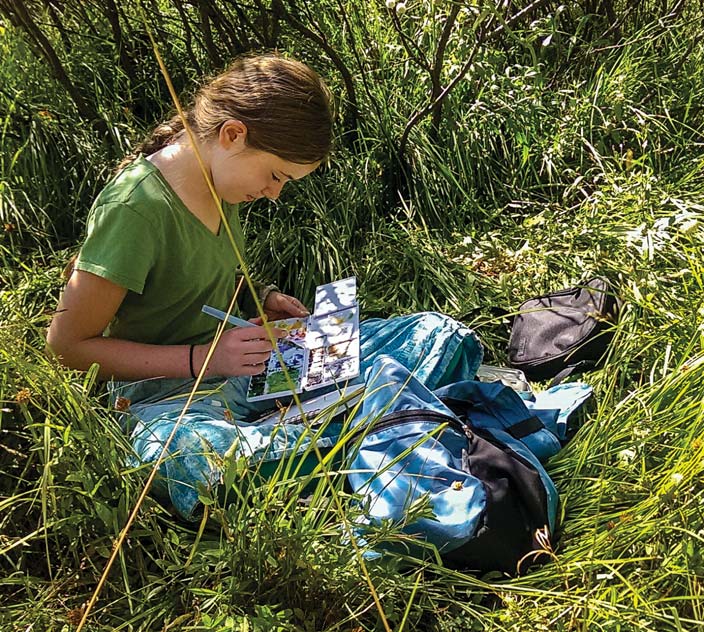
This done, you can begin thinking about what you want to put in your journal. Laws advises his students to chase after two things: beauty and wonder. Often, these things will not announce themselves immediately.
With careful observation and attention, they will come into focus, and you’ll discover that even familiar objects like a pinecone are infinitely complex and beautiful, filled with small mysteries worth thinking and writing about.
In translating this to the pages of your journal, Laws advises using what he calls the three languages of nature journaling: writing, drawing and quantification (measuring, estimating, timing, or counting).
Using these languages in tandem reveals new patterns, spurs new connections between ideas and stimulates different parts of the brain.
“Drawing can be anything from maps to diagrams to cross-sections; it doesn’t have to be a portrait or likeness of something,” Laws said. “The writing can be lists, bullet points, narrative paragraphs, or short sentences or labels connected to a drawing.”
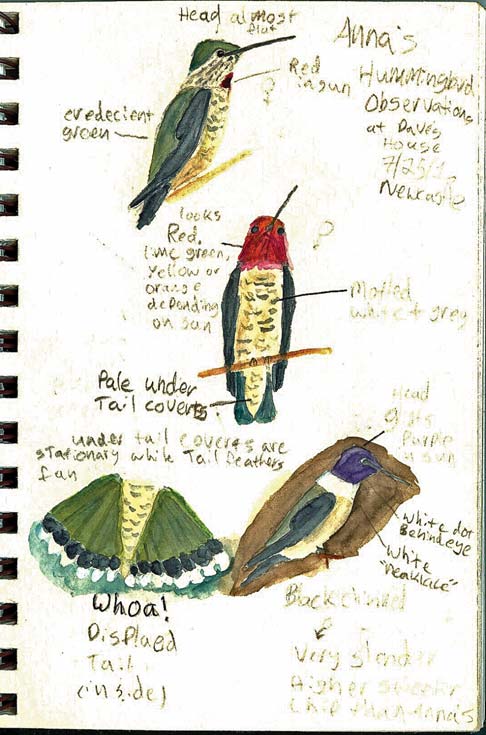
If you haven’t drawn anything in a while, this part will probably be a bit scary. But the point isn’t to make a pretty picture, Laws said. The point is to get your brain down on paper, to use drawing as a tool to investigate the world. It doesn’t matter how good the drawing is, though if you keep at it, your work will inevitably improve. Similarly, when writing, don’t worry about spelling or grammar. Nobody is grading this; this is a space to play.
The three languages – drawing, writing and quantifying – will help you describe what you’re seeing. The second step is to ask questions, and through pondering them, you can begin to explain, for yourself, the small mysteries you are seeing. Use a journalist’s toolkit of questions to get started: who, what, when, where and why.
Laws’ third step is to intentionally draw connections between what you see and other things you have observed, experienced or already know, adding a rich personal dimension to the experience and bringing your observations to the next level.
These three steps boil down to a series of easily remembered prompts: “I notice,” “I wonder,” and “it reminds me of.”
Because of the discipline and effort nature journaling takes, it can be discouraging for a beginner. But Laws recommends reframing the way you think about the experience. “If you go out and journal, and you notice something you otherwise would not have noticed, or you remember it more vividly, or you were able to come up with some questions about what you were looking at, or were more curious about something you saw, then that journaling experience was successful.”
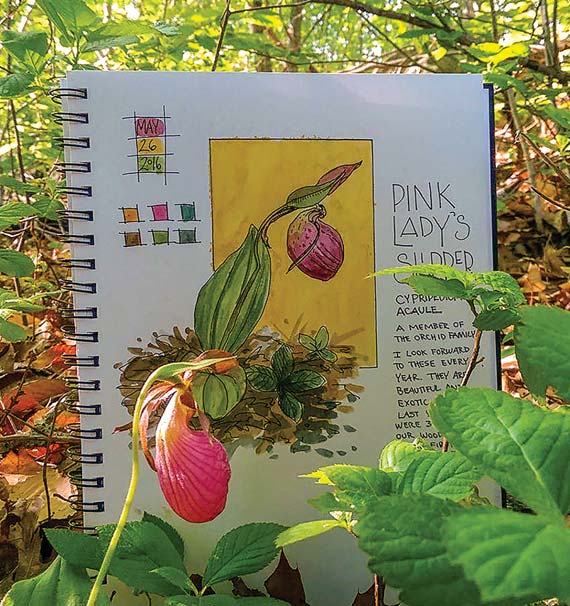
A First-hand Account
As part of research for this article, I began nature journaling myself. I quickly encountered the truth of what I’d been told: this does take discipline. I resisted making time to do it. Committing to go out with a notebook and doing something that I wasn’t used to felt like a waste of time.
The first time I journaled, I felt like a fool. I can’t tell an oak tree from an elm, but I wanted to emulate the other journals I’d seen in which every plant drawing was confidently labeled. Luckily, I work on the University of Nebraska-Lincoln’s East Campus, where the gardeners have seen fit to plant numerous signs in their gardens. I plopped myself on a sidewalk next to a crimson lily and went to work. (Addendum: I told Laws about my strategy later, and he encouraged me to observe things I don’t know the names of, as the point of this is seeing what you can learn and observe yourself, not through others.)
It was rough. I hadn’t drawn in a long time, and I quickly became frustrated. But as I stared at the dying plant, I decided to try Laws’ “it reminds me of” tactic, and something lit up in the dark recesses of my brain, the part that spent hours reading English literature for college. I wrote about the lily’s “long cane-like stalks standing proudly,” with “pale green and grey leaves strewn at its feet like discarded laundry.” Discarded laundry. That was interesting, I thought. It felt like writing poetry – something that is terrifying to me – but in that moment, it came perfectly naturally. I didn’t know that part of me was still there.
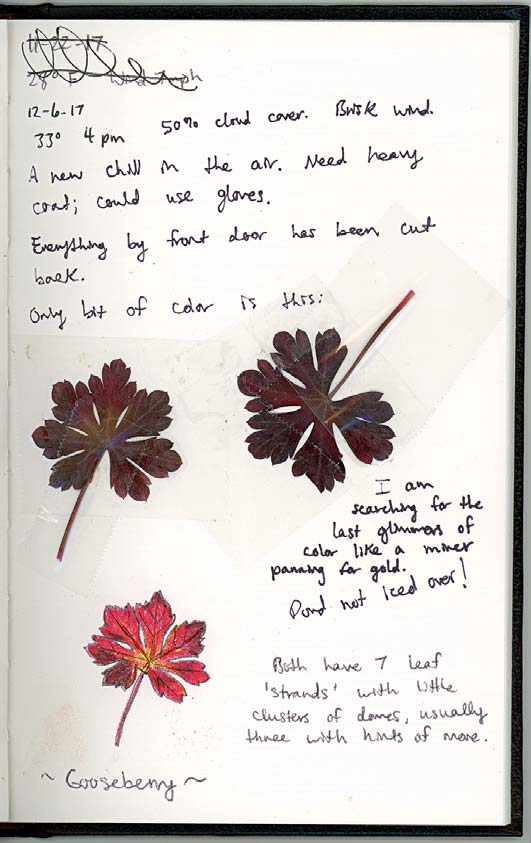
The second time I went out, I was more detailed in my journaling, and ended up making a memory. Looking at the page now, the day comes back to me in vivid detail: the lawns of East Campus painted with long shadow and golden light, the wind sighing through the leaves, boys chasing each other between the trees. I visited a bright yellow shantung maple, one of the few trees still holding color on that mid-November day, and studied it, drawing its pointed leaves and admiring an expertly constructed nest. I went back to my desk and Googled shantung maples, spending a good half hour reading about their characteristics and why the leaves look the way they do. I can’t say that the structure of maple leaves was something I ever thought I’d find interesting, but it happened. It was definitely a new experience.
The third time I went out, I noticed a change in my body. “I feel my heartbeat slow. Stress dissolving,” I wrote. It was a good feeling, worth going after again. I’m going to try to keep journaling. It’s not a habit, not yet, so I expect to still feel some discomfort. But I want to see that shantung maple’s yellow flowers in the spring. I want to learn the difference between an oak and an elm. I want to pick up on the nuances of the seasons as they cycle through and really see what’s going on around me. Most importantly, I want to reconnect with the 8-year-old me who couldn’t go a day without playing outside, who lost that love for the outdoors as she grew up. I know it’s still there. In the pages of this journal, I see it slowly coming back.

Written by Renae Blum
Renae works for the Nebraska Game and Parks CommissionEducators interested in using nature journaling in the classroom can find a comprehensive curriculum, “Opening the World through Journaling: Integrating art, science, and language arts,” at johnmuirlaws.com.
Naturalists at the Nebraska Game and Parks Commission periodically hold nature journaling workshops. Contact the following to find out about upcoming workshops in your area:
- Alison Bleich of Lake McConaughy State Recreation Area
- Bobbi Holm of Fremont Lakes State Recreation Area
- Holly Green of Fort Kearny State Recreation Area
The post Discovering the Outdoors Through Nature Journaling appeared first on NEBRASKALand Magazine.














